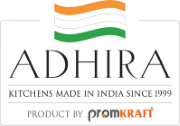History of the Indian Kitchen
Until the beginning of the twentieth century, Indian kitchens didn’t even have platforms or storage cabinets. Mostly women, and some men, cooked on earthen choolas (stoves) mounted in the distant corner of the kitchen, and things were kept around in sacks, barrels, tins and, of course, large wooden cupboards built into walls. Post-Independence, however, people began to realise the concept of having an organized kitchen – a waist-length platform for the stove, the space under it utilized for storing the most commonly used everyday items and an overhead cabinet for more storage. Another important change was the inclusion of the sink at one corner of the platform with running tap water – a miraculous luxury thanks to modern plumbing! Now the kitchen sported a clean, neat, organized look with more open space. Most importantly, women were spared their umpteen daily sit-ups and hence left with more energy and time to lavish on the family.
In such a rudimentary set up, the first material to be used for kitchen platforms and even storage cabinets was stone slabs, preferably the ubiquitous black cudapa. Decades later cudapa was replaced with marble and granite. Solid wooden slats, known for their durability were preferred for cabinets. Generations passed before the Indian kitchen saw the entry of the miracle material of the century – plywood. Much cheaper than solid wood, smarter, easier to work on and giving a better finish!
Sadly, even after the turn of the millennium most people still believe that plywood is the only and best material for the kitchen. And the more ‘knowledgeable’ ones are convinced that the best quality plywood is marine ply, with nothing beyond that. Talk about ignorance!
All about Plywood
Plywood is an engineered wood comprising several layers of wood (called veneers) glued together and pressed to form uniformly plain sheets. And that’s just about all that the average person knows about plywood!
What very few people know is that not all plywood is the same. There are very many varieties, like softwood ply (with veneers from trees like pine, redwood, cedar etc.) and hardwood ply (from birch, maple, oak, walnut etc.); aircraft plywood, exterior plywood, lumber core plywood, marine plywood, overlaid plywood, finishing plywood and structural plywood. Also plywood comes in various thicknesses according to the number of veneer layers, such as 3-ply, 5-ply, 9-ply going up to 15-ply. Moreover, plywood is graded as A, B, C and D, with A being the best and D being the lowest quality. Boiling Water Resistant (BWR) and Boiling Water Proof (BWP) plywood are considered the toughest and best varieties nowadays. Different types of plywood with different characteristics are used in a wide variety of applications like cabinetry, furniture, wall panelling, skirting, internal and external sheathing, flooring and roofing, musical instruments, sports equipment, building construction, automobiles, ship building, packing crates etc.
In recent decades newer materials such as Composite Woods, Block board, Foam board, Fibreboard, Hardboard, Particleboard and Moisture-resistant Particleboard entered the Indian scene. Nevertheless, plywood continues to be the most preferred material for furniture, including kitchens.
Shortcomings of Plywood
Even so, one needs to understand that plywood isn’t the most suitable material for kitchens on account of some inherent flaws. First and foremost, ply does not give uniform thickness due to its multiple layers. This leads to bending and warping issues in it after some time. Even the highest grade BWP variety plywood can sustain water for only up to 72 hours, after which it starts peeling off.
Due to extreme changes in Indian seasons, moisture content is high in Indian atmosphere. This causes plywood to shed powder and also attract termites. Spilled water and food particles seep into the soft porous surface of the ply, resulting in unpleasant infestation and moulding. Moreover, plywood is neither fire retardant nor waterproof. Yes, not even the so called Marine or Water Resistant ply!
Read also: ‘FURNITURE’ TRADITION OF FURNITURE IN INDIA
Welcome to HDHMR!
To overcome all these problems, an Indian Company Action Tesa brought out a revolutionary new material called High Density High Moisture Resistant (HDHMR) board. Made by mixing and pressing forest wood waste and fibre chips, the compression of hardwood particles through an industrial adhesive produced a robust material. HDHMR has the best routing characteristics due to its very high and uniform density gradient and compact core. This rendered it termite resistant and borer proof. It is extremely strong, does not peel and cannot be scratched easily. It is fire retardant and has amazingly high water resistance. Its constant 18 mm thickness prevents HDHMR from bending and warping issues. What’s more, HDHMR is absolutely hygienic, contamination and smell proof and has high weight-bearing capacity without sagging. As it can be polished to a high gloss mirror finish it keeps your kitchen shiny, chic and trendy for years without needing any maintenance!
HDHMR – The need of the hour!
Perhaps the greatest miracle of HDHMR board is that it is the most ECO-FRIENDLY material currently available. The common public is blissfully ignorant of the fact that the plywood uses some chemicals that keep emanating tiny amounts of toxic fumes into the air, not only during the manufacturing process but also for years after installation. Imagine living in a house with a toxic kitchen!
On the other hand, HDHMR is made paying particular attention to all aspects related to environment protection and safety of use. It avoids even small traces of chemicals that may affect the health and safety of people that come in daily contact with it. As most of the ingredients are water-based, the only significant evaporation into the atmosphere is actually made of water. They are totally free from hazardous materials, PAH (Poly-cyclic Aromatic Hydrocarbons) as well as all heavy metals.
So go for HDHMR kitchens – the strongest, toughest, safest, driest, prettiest and hence the best material for your kitchen! For, your family deserves the best, doesn’t it?





